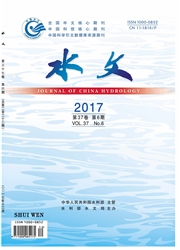

 中文摘要:
中文摘要:
气候变化环境下三角洲感潮河段洪潮耦合条件改变。除高水位量级外,其集中期特征与变化规律也是体现三角洲洪水情势变异的重要因素。采用圆形分布法计算得到珠江三角洲16站的高水位集中日、集中度、高峰期的起止时间等集中期特征,并分析其多年变化规律。结果发现:(1)是否考虑水位量级对于由圆形分布法计算得到的水位集中性没有显著影响;(2)珠三角入口与口门站点的高水位集中期比网河站长;(3)入口与网河站的集中日相近,口门站集中日最迟;珠三角大部分站点的高水位集中日有延后倾向,而发生时间趋于集中稳定;(4)入口及口门站点的集中日波动性都高于网河区站,且珠三角集中日波动性有随时间推进而减小的趋势。研究结果为三角洲洪水情势变异分析提供了新角度,为珠江三角洲的高水位采样、频率分析及重现期设计值计算提供数据基础,并为区域防洪减灾政策制定提供理论支持。
 英文摘要:
英文摘要:
In deltas, the flood-tide coupling mechanism in tidal rivers changes under the impact of the climate change. Apart from the magnitude of high water level, the timing and its seasonality are also important factors that can reflect the varied flood regime. This research has adeopted a directional statistics methodology, and generated the characteristics of high water level seasonality, i.e., the concentraction time, ratio, period as well as the their changing patterns over the decades. The Pearl River Delta has been set as the study area, and the recording high water level along with the timing of 16 hydrological stations have been studied. The results show that: (1) there is no significant difference in the seasonalitycalculated by the circular distribution method with the magnitude of water level is considered; (2) the high water level concentration period of both outlet and income stations are longer than that of the river net; (3) the concentration date of outlet stations are similar to river net, and previous to that of income stations; the delay in the concentration time becomes statble around the whole Pearl River Delta; (4) the fluctuation of concentration date is stronger in the oulet and income stations than the river network, but the fluctuation becomes slight during the last four decades. The study provides a new perspective in analyzing delta flood variation, and a theoretical base for the sampling and frequency analysis of the high water level. It can serve as a theoretical support for making the regional flood protection policies.
 同期刊论文项目
同期刊论文项目
 同项目期刊论文
同项目期刊论文
 期刊信息
期刊信息
